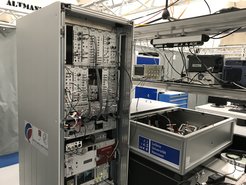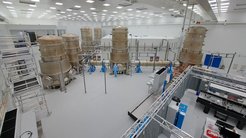Laser light to pave the way for the Einstein Telescope
High-precision laser source from Hannover for the ETpathfinder in Maastricht
Researchers from the Max Planck Institute for Gravitational Physics (Albert Einstein Institute; AEI) and Leibniz University Hannover have set up, tested, and commissioned a laser source in a laboratory at the ETpathfinder site in Maastricht. ETpathfinder is a research and development facility for the Einstein Telescope, the future third-generation European gravitational-wave observatory. Later this year, in addition to further characterization, the first preliminary tests are planned to integrate the laser system into ETpathfinder. Full integration and regular experiments with the new laser source in ETpathfinder are scheduled to begin next year.

As a first step, researchers from the AEI Hannover shipped their laser source to Maastricht. There, together with ETpathfinder colleagues, they set up the laser system in a clean room laboratory, checked that all components were functioning correctly, and put the system into operation.
“The transport to Maastricht and the installation of our new laser source at ETpathfinder went perfectly,” says Nicole Knust, a PhD student at the AEI Hannover. “The high-precision device now works just as reliably in Maastricht as it did in our laboratory in Hannover and is ready for further integration into ETpathfinder.”
New high-precision technology for new detectors

Third-generation gravitational-wave detectors – such as the Einstein Telescope in Europe and Cosmic Explorer in the USA – will differ significantly from today's instruments in some aspects and will require the use of new technologies. For example, the Einstein Telescope will be partially cooled to temperatures of -263 °C in order to achieve a particularly high sensitivity to gravitational waves. As a consequence, mirrors and beam splitters must be made of other materials than those of current detectors. However, these materials are not transparent to the laser light used in currently operating gravitational-wave observatories. Lasers of different wavelengths must therefore be employed.
The laser source developed at the Max Planck Institute for Gravitational Physics (Albert Einstein Institute) and at Leibniz University Hannover generates infrared laser light with a wavelength of 1550 nanometers and a power of 10 watts.
“Future gravitational-wave detectors will place very high demands on their laser sources. To meet these requirements, we have devised high-precision technology to control and actively stabilize the brightness, color, beam shape, and beam position of the long-wavelength laser light,” says Fabian Meylahn, a postdoctoral researcher at the AEI Hannover.
“In the coming weeks and months, we will fully characterize our laser system with further measurements and integrate it into the data acquisition system,” says Nicole Knust, “After that, the first tests will be carried out in which the laser light will be coupled with optical components in ETpathfinder's vacuum system.”
ETpathfinder profits from decades of experience in Hannover
ETpathfinder is a research and development infrastructure in Maastricht (operated by a collaboration for more than twenty research institutes from seven European countries) to test, develop, and characterize the compatibility of many innovative concepts and technologies required for the Einstein Telescope in one place.
“ETpathfinder is an important step on the way to future gravitational-wave detectors such as the Einstein Telescope. With our laser source, we are contributing a core part of ETpathfinder,” explains Benno Willke, leader of the “Lasers and Squeezed Light” research group at the AEI Hannover and at Leibniz University Hannover. He adds: “By operating our laser source at ETpathfinder, we can put it through its paces and expand our decades of experience in the construction and operation of such laser systems.”

The Cluster of Excellence QuantumFrontiers with the Topical Group “Laser Development and Stabilization for Next-Generation Gravitational Wave Detectors” and the Federal Ministry of Education and Research have funded the development of the laser system for ETpathfinder.















